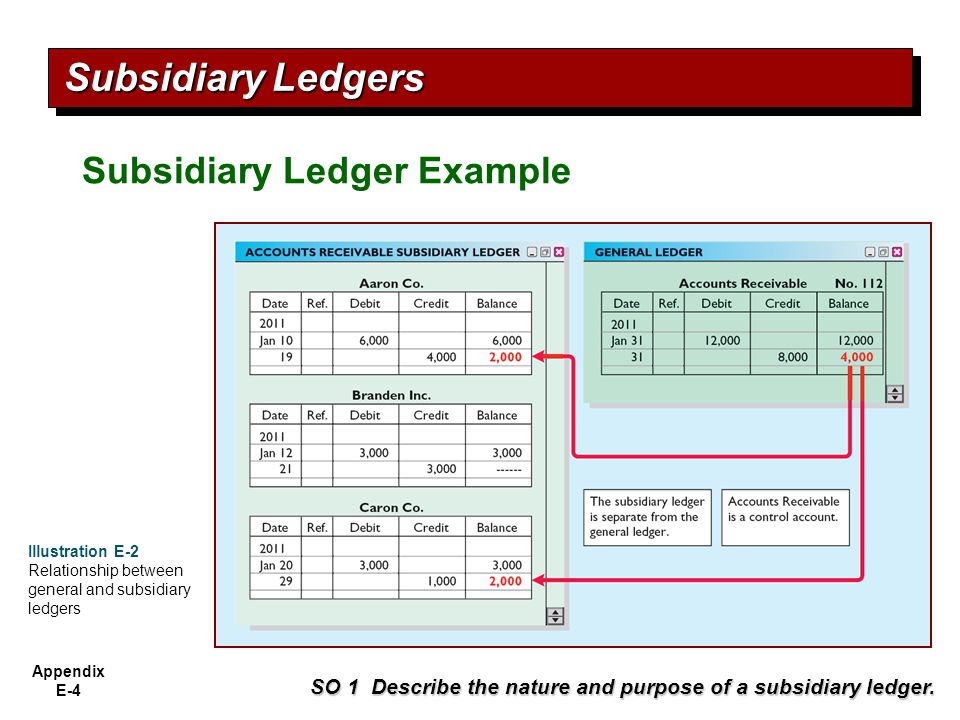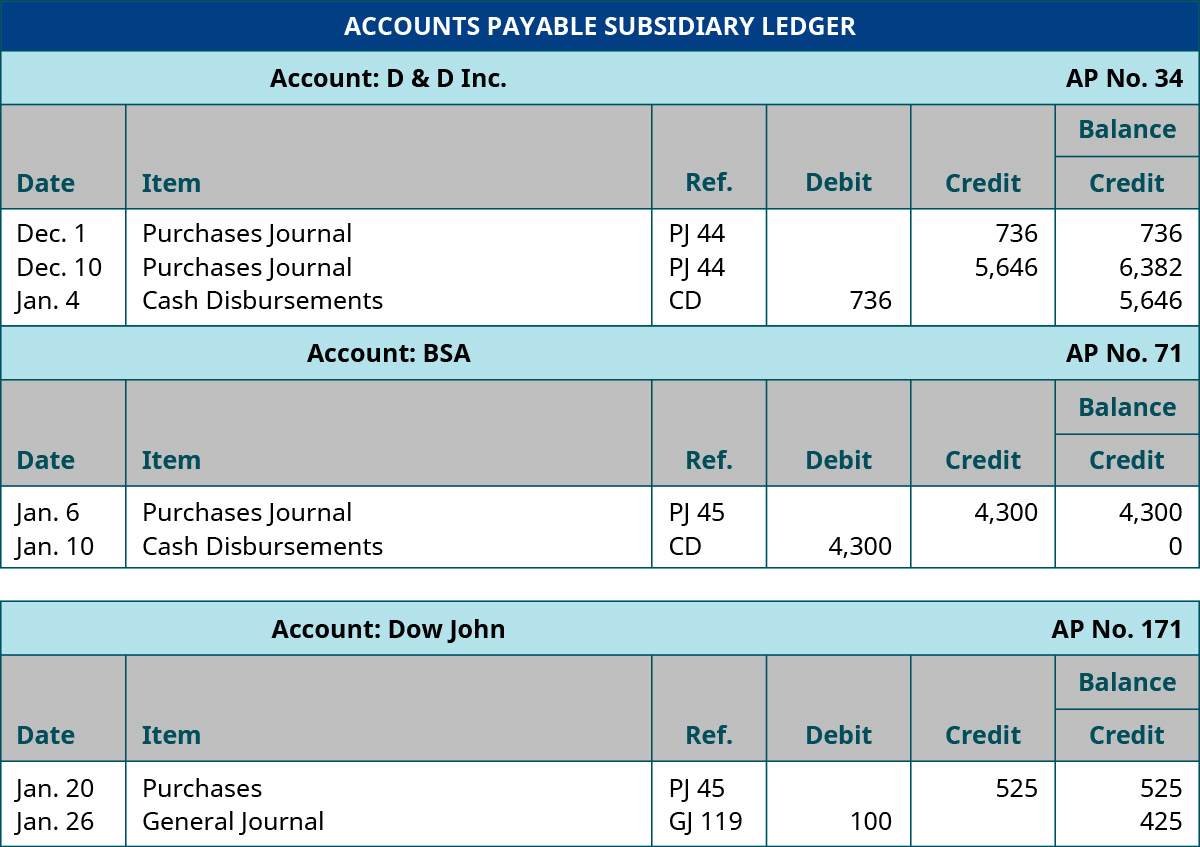Subsidiary ledgers can be used to organize data in a specific way. Accounts Payable Accounts Receivable and Owners Equity subsidiary ledgers.

Subsidiary Ledgers And Special Journals Ppt Video Online Download
Payroll subsidiary ledger is used to manage both salaries and wages.

. By Obaidullah Jan ACA CFA and last modified on Oct 10 2014 All Chapters in Accounting. Subsidiary ledger can be defined as. Two common subsidiary ledgers.
A subsidiary ledger is useful to accountants and bookkeepers for a variety of reasons. A Accounts Payable Accounts Receivable and Owners Equity subsidiary ledgers. Definition of Subsidiary Ledger.
Click card to see definition. For instance the subsidiary ledger for accounts receivable contains the information for each of the companys credit sales to customers each customers remittance return of merchandise discounts and so on. List of individual subaccounts and amounts with a common characteristic linked to a controlling account in the general ledger.
-Accounts Receivable Accounts Payable Cash Checking Petty Cash and Owners Equity subsidiary ledgers. A selling company lends money to a customer company to be used to purchase goods from the selling company. However they are usually only created for areas in which there are high transaction volumes which limits their use to a few areas.
Sales ledger purchase ledger cash book etc. The general ledger is nothing more than the total of the balances in the subsidiary ledgers. An accounts receivable ledger includes individual accounts that apply to each individual customer.
Accounts receivable subsidiary ledger where data relating to individual buyers are kept. -Cash and Owners Equity subsidiary ledgers. In subsidiary ledgers individual ledger accounts are maintained in alphabetical order.
Some of the more common subsidiary ledgers are. It is much easier to review data when it is organized and grouped together. If a business uses control accounts there are two options with subsidiary ledgers either the subsidiary ledger itself forms part of the double entry bookkeeping system and the control account is for information only or the control.
How each company sets up their bookkeeping will depend on the business needs. For example accounts receivable subsidiary ledger can be used to track accounts receivable by who customer. The AR subsidiary ledger should agree.
You can record calculations payments made to each of the employees in this sub-ledger. This record groups all of the vendors and. As a result the sum of balances of subsidiary ledgers is always.
The Payroll subsidiary ledger is used to process all types of payroll transactions for the purpose of computing and paying your salaried employees or time and labor-based contractors. B Accounts Receivable and. The general ledger will normally contain a control account for each subsidiary ledger eg.
Examples of subsidiary ledgers are the accounts payable ledger accounts receivable ledger fixed assets. Accounts payable subsidiary ledger and fixed assets subsidiary ledger are other commonly used subsidiary ledgers. To resolve this issue most companies maintain subsidiary ledgers which provide customer wise transaction details opening and closing balances.
This is because maintaining a subsidiary ledger entails additional costs. A subsidiary ledger contains the details to support a general ledger control account. For example they have customers that owe them money many types of.
First it groups related accounts into one ledger that can be easily totaled and analyzed. Some of the commonly used subsidiary ledgers are Fixed Assets Accounts Payable Accounts Receivable Projects and Inventory and they all send the financial data to General Ledger. The subsidiary ledgers have all the detail.
25 of possible 25 points Some of the more common subsidiary ledgers are. Here are some common types of subsidiary ledgers that businesses may decide to create. A company might keep a subsidiary ledger for its customer accounts each of which connects to the accounts receivable totaled in the general ledger.
Each entry is recorded in respective subsidiary ledger as well as the respective main ledger which is also called the control account. -Accounts Payable Accounts Receivable and Owners Equity subsidiary ledgers. -Accounts Receivable and Accounts Payable subsidiary ledgers.
Some of the more common subsidiary ledgers are. Accounts payable subsidiary ledger is due where data relating to individual creditors are kept. Common examples of subsidiary ledgers that businesses typically maintain are the following.
Question 13 of 40 Score. Businesses must track a lot of things in order to manage their money and ensure they keep making profits. Two common subsidiary ledgers are the Accounts Receivable Ledger and the Accounts Payable Ledger.
Common subsidiary ledgers include an accounts receivable ledger and an accounts payable ledger. Companies incorporate several types of subsidiary ledgers in their accounting systems. Take the accounts payable ledger for example.
This makes it not worth it for accounts that have low transaction volumes. SUBSIDIARY LEDGERS SUBSIDIARY LEDGERS. Some of the more common subsidiary ledgers are A accounts payable accounts receivable and owners equity subsidiary ledgers B accounts receivable and accounts payable subsidiary ledgers C accounts receivable accounts payable cash checking petty cash and owners equity subsidiary ledgers D cash and owners equity subsidiary ledgers.

Prepare A Subsidiary Ledger Principles Of Accounting Volume 1 Financial Accounting

Subsidiary Ledgers And Special Journals Ppt Download


0 Comments